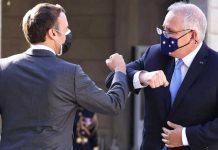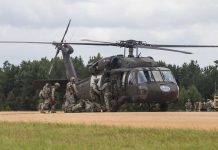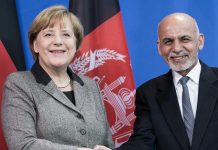The US withdrawal from Afghanistan at the end of last August ended the longest war fought by the United States in its history, after it started in 2001 after the bloody attacks that hit the New York trade towers and was claimed by Al-Qaeda. 20 years and covered several theaters in the region and the world?
9/11 attacks
On the morning of September 11, 2001, the United States was subjected to unprecedented attacks by 19 elements of the “Al-Qaeda” organization, by hijacking 4 planes, killing about 3,000 people.
The attacks saw the hijackers fly two planes towards the north and south towers of the World Trade Center complex in New York, while the third plane headed to the Pentagon in Washington, while the fourth plane (which was initially headed towards Washington, DC) crashed in a field in Pennsylvania, killing one All those on board, after the passengers tried to resist the hijackers.
Al-Qaeda claimed responsibility for these attacks, before broadcasting videos of its 19 hijackers.
Bush declares ‘war on terror’
Five days after the attacks, considered the deadliest on American soil in history, Congress passed the Authorization for the Use of Military Force, which allows the use of US forces against those responsible for the September 11 attacks and any forces associated with them.
Soon, President George W. Bush declared a “war on terror”, calling on the countries of the world to join the United States, and said in a speech to the American nation: “Every country in every region now has a decision to make…either you are with us or with the terrorists.”
On the same day, Bush used the term “war on terror” for the first time, to describe the global campaign led by the United States, and said during a televised address to Congress: “Our war on terror begins with al-Qaeda, but it does not end there. Every terrorist group with global reach, stop and defeat them.”
Invasion of Afghanistan
After the Taliban ignored American warnings to abandon support for “Al-Qaeda” and hand over the organization’s leader, Osama bin Laden, the United States began on October 7 a large-scale military campaign in Afghanistan with the participation of a number of countries.
Operation Enduring Freedom was launched with a joint attack by US and British forces with the help of anti-Taliban Afghans who had gathered in the so-called “Northern Alliance”.
At first, American planes launched large-scale raids on the mountains of Tora Bora, where Osama bin Laden was holed up, before he managed to escape and hide for 10 years.
Guantanamo Bay
In January 2002, while the military operations of the United States and its allies were continuing in Afghanistan, Guantanamo Bay, a US military prison located inside a naval base on the Cuban coast, was opened.
Washington established the camp as part of the “war on terror”, whereby it detains and interrogates suspects who are considered very dangerous people, and among the most prominent detainees in Guantanamo is the mastermind of the September 11 attacks, Khaled Sheikh Mohammed, and his partner in planning and coordination, Ramzi bin al-Shibh, who were arrested by US intelligence Ami 2002 and 2003.
However, the detention camp was soon subjected to widespread human rights criticism, due to the prolonged detention of inmates without trial, as well as the fact that they were subjected to torture.
Amnesty International declared that the operations inside the prison constitute a grave violation of human rights, but the Bush administration said that the Guantanamo detainees are not on US soil and are therefore not covered by the US Constitution.
Iraq invasion
The US war on Iraq began on March 20 to topple Saddam Hussein’s regime on the pretext that it possessed weapons of mass destruction, before it became clear later that these allegations were false.
And soon the Iraqi army collapsed a few weeks after the start of operations, and on December 13 of the same year, US forces managed to arrest Iraqi President Saddam Hussein on a farm near his hometown in Tikrit, then he was imprisoned for several years before being executed by his opponents from the Iraqi groups at dawn Eid al-Adha on December 30, 2006.
Abu Musab Al-Zarqawi
On October 17, 2004, Abu Musab al-Zarqawi, who was already leading attacks against the Americans in Iraq, formed an alliance with Al-Qaeda and pledged allegiance to Osama bin Laden, later becoming the organization’s leader in Iraq. Two years later, Al-Zarqawi was killed in a US air strike on June 7, 2006.
War emblem changed
In March 2009, the US Department of Defense officially changed the name of military operations from the “war on terror” to “Operation Foreign Emergency,” as the Obama administration asked Pentagon employees to avoid using the former term, but the Bush administration’s primary war goals, such as targeting Al-Qaeda and building international alliances to combat terrorism remained in place.
The same year witnessed the withdrawal of most British forces from Iraq by April 30, 2009, while a small division remained, mostly from the Royal Navy as part of the training and advisory mission, and then the complete withdrawal took place on May 22, 2011.
Osama bin Laden
In the early hours of the morning of May 2, 2011, a group of US special forces raided a residential complex in Abbottabad, northern Pakistan, killing the leader of the “Al-Qaeda” organization, Osama bin Laden, in an operation that did not last more than an hour, followed by burial of his body at sea.
Al-Qaeda confirmed the fall of its leader on May 6, vowing revenge, then Ayman al-Zawahiri took over the organization’s leadership. The US strikes have greatly weakened the organization’s capabilities, but they have not been able to eliminate it completely.
Anwar Al-Awlaki
On September 30, 2011, a US drone strike in Yemen succeeded in assassinating Anwar al-Awlaki, an al-Qaeda leader and a US citizen, becoming the first US citizen to be deliberately targeted with a direct strike.
The assassination of the leader of the Pakistani Taliban
On November 1, 2013, a US drone strike killed Hakimullah Mehsud, the leader of the Pakistani Taliban. The organization was formed in December 2007 when 13 groups united under the leadership of Mehsud, and are active mostly in the tribal areas along the border with Afghanistan.
Declaring war on ISIS
Following the ISIS takeover of the Iraqi city of Anbar, an international military coalition led by the United States, comprising 83 countries, was announced to fight the organization. Then the military campaign expanded to include targeting ISIS sites, whose control extended to other areas in Iraq and Syria.
The end of the war in Afghanistan
In December 2014, Washington officially announced the end of the war in Afghanistan while maintaining 10,000 troops. In the same month, NATO ended its 13-year combat mission, but kept a number of troops to train the Afghan army.
The assassination of Abu Bakr al-Baghdadi
On October 27, 2019, US forces carried out an operation that resulted in the fall of ISIS leader Abu Bakr al-Baghdadi, in a village in Idlib countryside, northern Syria.
Doha agreement
On February 29, 2020, the United States and the Taliban announced an agreement had been reached after months of talks in the Qatari capital, Doha.
The agreement provided for the complete withdrawal of US forces from Afghanistan in exchange for guarantees from the movement to bring peace to the country.
Final withdrawal
US President Joe Biden announced the complete withdrawal of US forces from Afghanistan by September 11, 2021, and in early May the United States and NATO began withdrawing 9,500 soldiers, including 2,500 Americans.
On August 31, the United States completed the withdrawal of its forces from Afghanistan after completing the evacuation of thousands of Afghan collaborators via an air bridge at Kabul airport.





